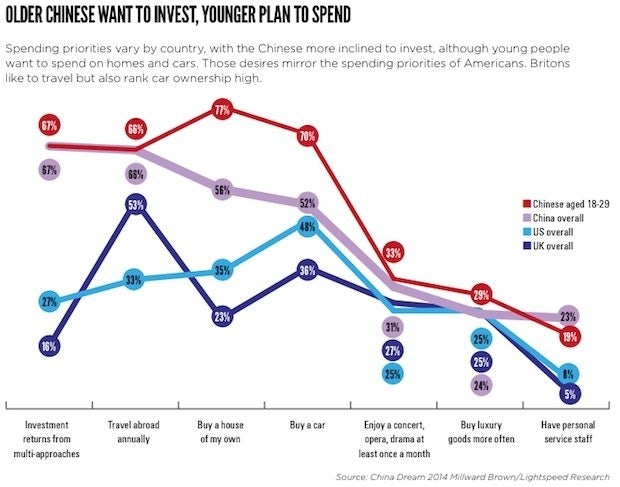
An infographic showing brands that match the Chinese Dream. (Millward Brown)
After China President Xi Jinping began promoting the concept of the “Chinese Dream” to the country’s citizens, analysts have been going over both what it means ideologically and whether or not it’s having an impact on Chinese citizens. A new study by research firm Millward Brown that surveys Chinese, American, and UK citizens about their own country’s “national dream” finds that the Chinese Dream certainly is having a major effect on society: it is considered the most important of all three countries, and impacts the outlook of Chinese respondents in many ways—including their outlook on personal finances and buying habits.
According to the report, 54 percent of Chinese respondents said they are “quite” or “very” familiar with the Chinese Dream, compared to only 43 percent of Americans when it comes to the “American Dream.” Furthermore, 70 percent of Chinese respondents said that having a national dream is a positive thing, compared to only 48 percent of Americans and 20 percent of those in the UK.
With a mixture of optimism about both personal economic prospects and China’s growing strength as a nation, the “Chinese Dream” is significantly different from that of other countries, meaning that foreign brands hoping to use it as a marketing tool will have to tailor their message specifically to its characteristics. As a result, the report describes several key strategies brands should take when crafting their communications to make sure that they align with the Chinese Dream:
Take it seriously.#
“Ignoring the Chinese Dream is not an option” for brands, says the report. Since many Chinese citizens truly believe in the concept of the Chinese Dream, brands needs to communicate that they believe in the dream and that their products support aspirations for “a better and more prosperous life,” according to the report. It also states that “smaller, privately owned brands” could especially benefit from embodying the Chinese Dream.
Customize your message for different generations.#
The study finds that different generations of Chinese respondents have different interpretations of what the Chinese Dream means for them economically, which means that brands need to tailor their messaging to accommodate the demographic they are trying to target. For example, the study finds that young Chinese respondents are more idealistic, optimistic about their ability to control their future, and interested in spending their money on a car or house than older generations.

Make sure your brand matches its ideals.#
The report states that brands that currently match the Chinese Dream’s characteristics “include both Chinese brands and international brands from a narrow range of categories.” However, “going forward, the opportunity to match the Chinese Dream is open to many more brands,” which should focus on strengthening their “emotional affinity” with Chinese customers.
Focus on corporate social responsibility.#
Social responsibility is a concept important to the Chinese Dream for many of those surveyed, according to the report. Brands need to convey an image that they respect the environment, care about labor conditions, and ensure product quality and safety in order to appeal to socially conscious Chinese consumers.
Anticipate change.#
“The Chinese Dream is not static,” says the report, and brands need to keep up with the ways in which Chinese society is rapidly changing. Brands that match today’s conception of the Chinese Dream may need to adapt in the future. “Dream-matched brands exhibit qualities associated with both stability and change,” says the report. “But these brands also can be different, fun, brave, desirable, and caring, characteristics that don’t describe the Chinese Dream of today but may offer a peek at the Chinese Dream of tomorrow.”